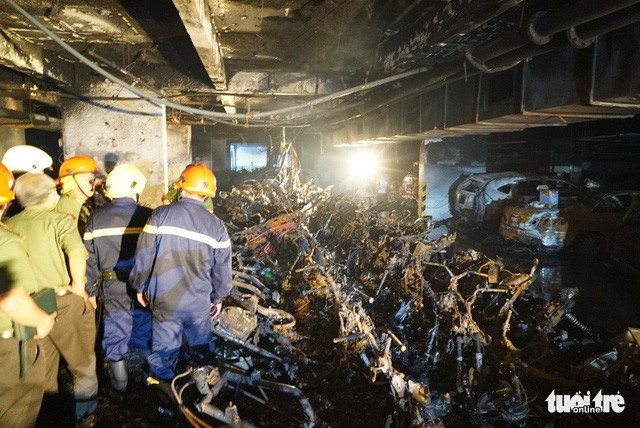By Stivi Cooke
High-rise fires remain a terrifying aspect of urban living in Vietnam
The tragic Carina Plaza fire in Ho Chi Minh City is yet another devastating reminder of the fire safety, evacuation, and prevention issues plaguing the city. With hundreds of apartment blocks higher than ten stories (the maximum reach of a fire truck ladder) – how likely are high-rise fires to remain a valid fear for Saigon residents?
I flew in to Ho Chi Minh City last week, passing over District 2 and its mammoth high-rise construction sites, including the nearly completed 81-story Landmark 81 skyscraper and its surrounding high-rise apartment complexes. A bird’s-eye view of the area reveals a city pock-marked by groups of tall apartment blocks with construction fueled by Vietnam’s burgeoning economy and policies aimed at attracting foreign investors keen to jump on the country’s property bandwagon. It’s not just Ho Chi Minh City or Hanoi either; Nha Trang and Da Nang both have massive apartment and high-rise projects nearly or fully completed.
Obviously, as you pack more people into these structures, the potential for disaster grows if issues aren’t well-managed. The situation only gets worse as mega-cities continue their unwavering expansion. Ho Chi Minh City is already estimated to house over 8 million residents and still more continue to flock from the countryside in search of a better life.
There are certain upsides of the increase in high-rise and new apartments. Newer buildings can and should (legally) have the most modern fire prevention and alarm systems. Modern construction designs can assist in preventing fires from spreading rapidly. Additionally, new laws on compulsory fire insurance are soon to take effect for the city.
Yet long after the Carina fire disaster is forgotten, it is likely the hazards will remain. Fire authorities have pointed to more than 10,000 buildings (schools, hospitals etc.) in the city with five or more floors that are at risk of fire or explosion. While the cause of the Carina fire hasn’t yet been established, there are far too many potentially deadly factors. Possibilities include fuel in the parking basement, faulty gas fixtures, trash blocking the escape routes, and fireproof doors left ajar.
The human factor must also be considered. After all, who’s to blame? Who polices the fire doors and checks the fire prevention systems? What are the responsibilities of the security guards and the building’s management team? I predict that this incident will force more legal changes to how urban apartments are managed and supervised.
Other issues are related to safety procedures in place after a fire starts. Should you stay or should you go? Hong Kong has long worked on the ‘protect-in-place’ idea – stay inside your fire-insulated apartment until firemen come. Australia, meanwhile, pushes the ‘evacuate’ principal. While evacuating a building works well in the early stages of a fire, most people only realize their building is engulfed in flames when it is too late to safely leave their apartment. The ‘protect-in-place’ plan has some advantages, including minimizing the risk falls and smoke inhalation (smoke usually kills more than fire) during evacuation. The most important thing to note, however, is that the success of any safety procedure depends on whether residents have been trained for fire drills and know their building’s safety plan.
Other large problems will take much longer to solve. Fire departments in Vietnam are often under-resourced and more than likely don’t have sufficient inspection procedures in place to cover the sheer number of potentially at-risk structures, particularly in smaller cities and towns in the country. Secondly, penalties may be too lenient and don’t put the fear of punishment or pressure on management companies to look after the safety of their building’s residents.
Perhaps part of the solution relies on tenants taking stronger action through legal means aimed at forcing building owners to act on hazards highlighted by their inhabitants. No risk can completely be eliminated so the occupants of these buildings should publicly hold their management boards accountable for lacking proper maintenance, violating fire codes, and allowing hazards such as rubbish in the stairwells and the unsafe storage of cleaning materials.
The important issue here is ensuring that tenants are enabled to achieve the removal of these hazards in a timely manner instead of waiting for years or being deliberately ignored by building owners, even if it takes the creation of new housing legislature.
We can’t prevent everything but we should enforce the rules for the safety of everyone. Hopefully, more Vietnamese will be willing to speak publicly to warn of fire dangers in and around their buildings.
One curious point however… Many apartment blocks now ban dogs and cats yet there were at least two examples of dogs in the Carina apartment fire warning their owners of impending danger – perhaps apartment managers should rethink their ban on these cute and cuddly early warning systems.

























































